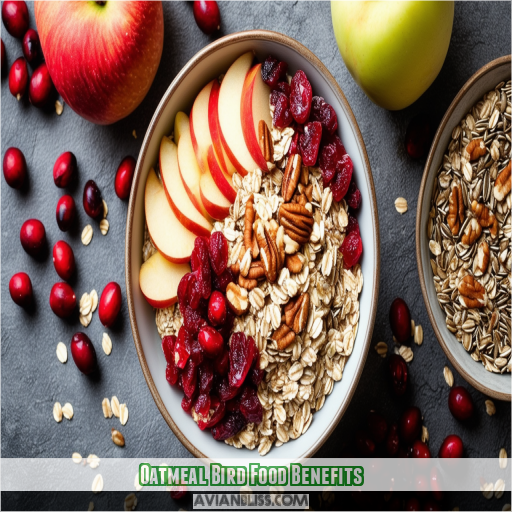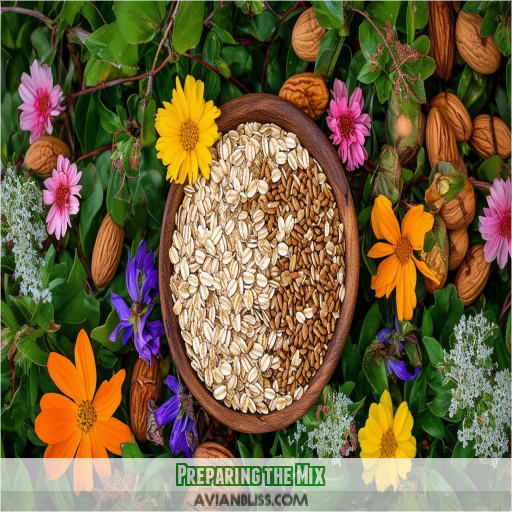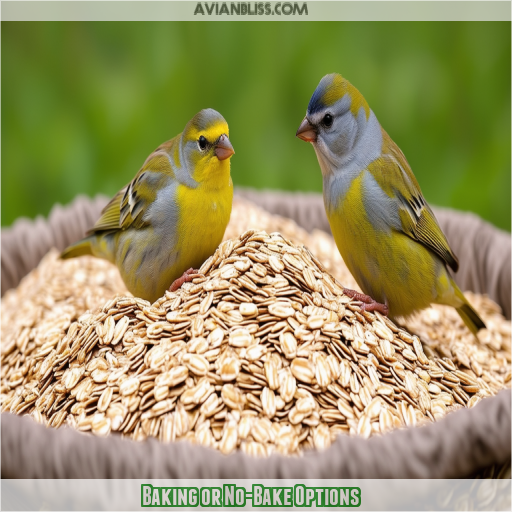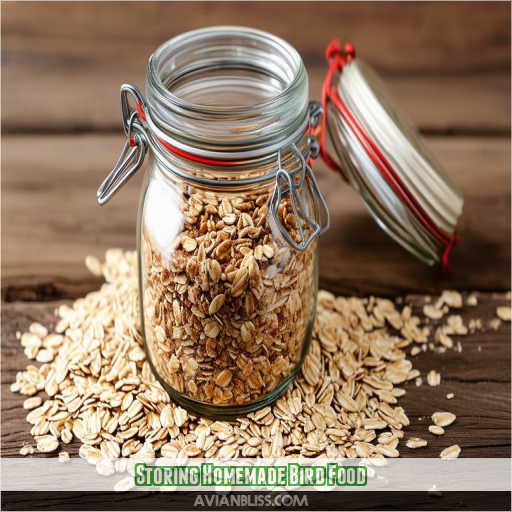This site is supported by our readers. We may earn a commission, at no cost to you, if you purchase through links.
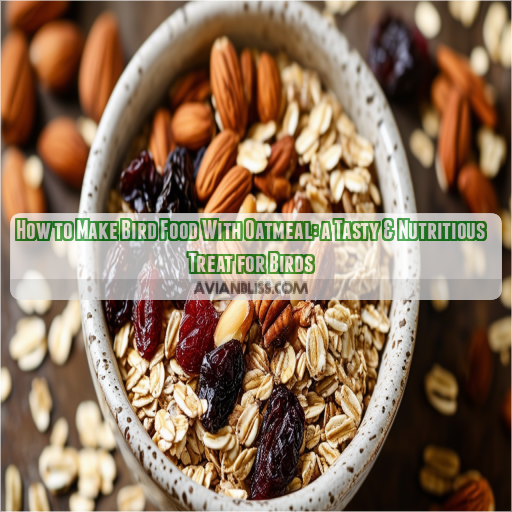
Start by combining dry ingredients like oats, nuts, seeds, and dried fruit in a bowl.
Next, add wet binders like melted suet, peanut butter, honey, or vegetable oil to hold the mixture together.
Form the blend into balls, logs, or fun shapes.
Bake in the oven at 325°F for 15-20 minutes, dehydrate for 8-12 hours at 135°F, or air dry for 1-2 days.
Customize with nut-free options, protein powders, or sweet and savory flavors.
Store in an airtight container for freshness.
Keep reading to discover more tips for creating this cost-effective, wholesome treat birds will flock to.
Table Of Contents
- Key Takeaways
- How to Make Bird Food With Oatmeal?
- Oatmeal Bird Food Benefits
- Ingredients Needed
- Preparing the Mix
- Baking or No-Bake Options
- Customizing the Recipe
- Storing Homemade Bird Food
- Offering Bird Food Safely
- Frequently Asked Questions (FAQs)
- Can you feed wild birds uncooked oatmeal?
- Can you make bird food with oats?
- How do you make easy homemade bird food?
- What can I feed birds if I have no bird seed?
- Are raw oats or cooked oats better?
- How long do the treats stay fresh?
- Can I use steel-cut or instant oats?
- What ratio of ingredients is recommended?
- Are there any nut-free substitutes for seeds?
- Conclusion
Key Takeaways
- Making homemade bird food is a fun, rewarding way to cater to our feathered friends’ dietary needs – a true labor of love for avian aficionados!
- Get creative and personalize your recipes with sweet, savory, or high-protein blends. The sky’s the limit when crafting customized cravings for your feathery flock!
- Proper storage is key to ensuring your nutritious creations stay fresh and appetizing. Stash your stash properly to keep those birds coming back for encores!
- Remember, happy and healthy birds require clean feeders and a watchful eye. Think of it as their own personal fine-dining experience – they deserve nothing but the best!
How to Make Bird Food With Oatmeal?
To make bird food with oatmeal, mix rolled oats with seeds, nuts, and dried fruit, then bind the mixture using ingredients like gelatin or corn syrup. Bake or dehydrate the mixture to create nutritious bird treats.
Oatmeal Bird Food Benefits
Preparing homemade bird food with oatmeal offers numerous benefits. The nutrient-dense oats provide an excellent source of energy and fiber. Incorporating nuts, seeds, and dried fruit boosts the treat’s protein and vitamin content.
With simple, cost-effective ingredients and easy preparation methods, making your own oatmeal bird food allows you to cater the recipe to your feathered friends’ specific dietary needs.
Nutritious Ingredients
Your homemade oatmeal bird food offers a nutritious blend of oats, nuts, seeds, and dried fruit – a varied smorgasbord that caters to birds’ dietary needs on a budget. The wholesome ingredients, from protein-rich sunflower seeds to antioxidant-packed dried fruit, provide essential nutrients for feathered friends, making it a guilt-free treat.
Easy Preparation
Preparing homemade bird food with oatmeal is a breeze. You’ll appreciate:
- The simple mixing process
- No baking required (unless desired)
- Minimal active time
With a few pantry staples, you can whip up a nutritious treat in minutes. Customize flavors to your feathered friends’ tastes for an engaging feeding experience.
Cost-Effective Treat
In addition to being easy to prepare, homemade oatmeal bird food is a cost-effective treat. You can save money by making it yourself, using inexpensive ingredients like:
| Ingredient | Cost |
|---|---|
| Oats | Low |
| Seeds | Low |
| Dried Fruit | Moderate |
With proper storage, your nutritious creations will delight birds while stretching your budget.
Ingredients Needed
To create homemade bird food with oatmeal, you’ll need a few key ingredients: old-fashioned oats as the base; a selection of nuts and seeds like almonds, walnuts, pepitas, and sunflower seeds for protein and healthy fats; and dried fruit such as cranberries, apricots, or raisins for added nutrition and flavor.
Additionally, you may require binding ingredients like honey, maple syrup, or coconut oil to help the mixture hold together.
Oats
As the star ingredient, oats bring a wealth of nutrients to your homemade bird food. They’re packed with:
- Protein for energy and feather growth
- Fiber for healthy digestion
- Antioxidants to support overall health
- Essential vitamins and minerals birds need
Making oatmeal bird treats is an easy way to provide birds with a nutrient-dense snack.
Nuts and Seeds
You’ll also want an assortment of nuts, like almonds, walnuts, and pecans, plus nutrient-dense seeds like sunflower, pumpkin, and flax. These provide essential fatty acids, protein, and crunch for the birds. Vary the nuts and seeds for different nutrient profiles and textures in your homemade bird treats.
Dried Fruit
Dried fruit adds sweetness and texture to bird suet. Use organic, chopped dried apples, cranberries, blueberries, or cherries. Avoid sulfured varieties as a healthy choice for birds. Whole dried fruit works too if finely chopped beforehand.
Binding Ingredients
In addition to dried fruit, honey, coconut oil, peanut butter, maple syrup, or water make ideal binding ingredients for oatmeal bird food. These help form delicious energy balls like tahini fig bars, date energy balls, brownie energy balls, apple pie energy balls, or blueberry muffin energy balls.
Preparing the Mix
To prepare the oatmeal bird food mix, start by combining the dry ingredients like oats, nuts, seeds, and dried fruit in a large bowl, stirring thoroughly to evenly distribute them. Next, add the wet ingredients such as melted suet, peanut butter, honey, or vegetable oil, and mix until the dry ingredients are well coated and everything starts to clump together.
Combining Dry Ingredients
Now that you’ve gathered your dry ingredients, it’s time to combine them:
- In a large bowl, mix the oats, nuts, seeds, and dried fruit.
- Thoroughly incorporate any additional dry ingredients like coconut or wheat germ.
- Guarantee an even distribution for balanced flavor and texture.
Adding Wet Ingredients
Next, you’ll add your wet ingredients – these act as binders. Opt for peanut butter, honey, or no-melt suet and adjust quantities for desired moisture content. Mixing thoroughly guarantees even coating on the oats. Consider temperature: room temp peanut butter blends easier than chilled honey or suet.
Forming Shapes
Once you’ve added the wet ingredients, it’s time to get creative! Shape the mixture into bite-sized balls, logs, or even novelty designs like hearts or stars. This adds an aesthetic appeal that birds will appreciate. Consider coating some in seeds or dried fruit for a pop of color and extra nutrition.
Baking or No-Bake Options
After thoroughly combining all the dry and wet ingredients, incorporating a variety of foods like seeds and fruits can provide essential nutrients and promote a balanced diet, as discussed in the importance of a best bird food for health. you have a few options for preparing the homemade bird food:
You can bake the mixture in the oven at a low temperature until it firms up and dries out slightly.
You can use a dehydrator to remove moisture and create crunchy bites.
You can simply air dry the formed shapes on a baking tray for a no-bake version.
Oven Instructions
You can bake the oatmeal bird food in a preheated 325°F oven for 15-20 minutes on a parchment-lined baking sheet. Let the treats cool completely on a wire rack before storing in an airtight container. This baking method creates crunchy, nutrient-dense "energy bites" that birds love.
Dehydrator Method
If you prefer a dehydrator, you can use it for an extended period to achieve the perfect texture. Set it to 135°F (57°C) and follow these steps:
- Arrange the shapes on dehydrator trays.
- Dehydrate for 8-12 hours, checking periodically.
- Remove when crisp but not rock-hard.
Adjust dehydration time for desired texture and flavor intensity. Monitor closely to prevent over-drying or scorching.
Air Drying
If oven space is limited or you prefer a no-bake option, air drying your oatmeal bird treats is a viable alternative. Simply spread the formed treats on drying racks or parchment-lined baking sheets and let them sit out at room temperature for 1-2 days, flipping occasionally. Once hardened, store in an airtight container for extended shelf life.
Customizing the Recipe
You can customize the oatmeal bird food to suit your feathered friends’ preferences and dietary needs. Opt for nut-free variations by substituting nuts with additional seeds or dried fruit, create high-protein blends by incorporating protein powder or soaked legumes, or experiment with sweet and savory flavors by adding cinnamon, cocoa powder, or savory herbs and spices.
Nut-Free Variations
For nut-free options, substitute seeds like sunflower, pumpkin or hemp for the nuts. Dried fruit variations add sweetness, and gluten-free oats accommodate dietary needs. Seed-only options provide essential fats and proteins. Adjust calorie content by including more seeds versus dried fruit. With creativity, you’ll craft nut-free bird treats suiting any flock.
High-Protein Blends
For protein-packed birdseed bars, add nuts like almonds, cashews, or peanuts; seeds like sunflower, pumpkin, or flax; plus dried fruit. Binders such as nut butter, mashed banana, or egg provide stickiness. This satiating blend sustains feathered friends during chilly winter days or exhausting migrations.
Sweet or Savory Flavors
You can further customize the flavors to your birds’ tastes. Consider these variations:
- Sweet: Add honey, molasses, or dried fruit
- Savory: Mix in herbs, spices, or savory seeds
- Fruit: Incorporate finely chopped apple, banana, or berries
- Veggie: Grate carrot, zucchini, or pumpkin into the mix
- Protein: Include cooked egg, mealworms, or crickets
Crafting tasty treats keeps birds interested and well-nourished.
Storing Homemade Bird Food
To maximize the shelf life of your homemade bird food, proper storage is essential. Refrigerating the oatmeal-based mixture in an airtight container can prolong its freshness for up to two weeks, while freezing it allows for storage of up to three months.
Refrigerator Storage
For short-term storage, refrigerate your homemade bird food in an airtight container to minimize excess moisture and air exposure that could lead to spoilage. The refrigerator shelf life is typically 1-2 weeks, but be sure to check for any signs of mold or dryness before offering it to your feathered friends. Thawed leftovers can be refrigerated for a few days.
Freezer Storage
You can freeze homemade bird food for long-term storage. Here are some tips:
- Portion into serving sizes
- Store in airtight freezer bags or containers
- Defrost overnight in the refrigerator before serving
- Reheat in the oven for a few minutes to crisp up
Freezing preserves nutrients and prevents spoilage, ensuring your feathered friends enjoy fresh, nutritious treats.
Airtight Containers
Airtight containers are essential for storing homemade bird food.
Plastic or glass both work well, but make sure they have tight-fitting lids.
Larger containers allow you to make batches, while smaller ones are handy for portioning.
Proper sealing techniques like squeezing out excess air help extend freshness.
Store containers in a cool, dry place away from heat and moisture for best results.
Offering Bird Food Safely
Proper feeder placement is essential for offering bird food safely. Position feeders away from areas with heavy foot traffic. Place them at a reasonable height to deter predators. Situate feeders in a sheltered spot to protect the food from rain and excessive sunlight.
Regularly monitor feeders for spoiled or moldy food. Clean them thoroughly with a mild bleach solution or vinegar. This helps prevent the spread of diseases and ensures the birds’ wellbeing.
Feeder Placement
When positioning your feeders, consider location, elevation, sunlight access, proximity to water sources, and shelter from harsh weather. Hang them at a comfortable viewing height and within 10-15 feet of shrubs or trees for quick cover if predators approach. Strategically placing feeders enhances your birdwatching experience while prioritizing feathered visitors’ safety.
Monitoring for Spoilage
You’ll want to keep an eye on your homemade bird food to prevent contamination. Frozen leftovers can last months, but refrigerated portions only last 1-2 weeks. Check regularly for mold, discoloration, or off-smells – signs it’s gone bad and needs discarding. Proper storage preserves freshness, ensuring birds enjoy a nutritious, safe treat.
Cleaning Feeders Regularly
Regularly cleaning feeders is essential for bird safety and hygiene. You’ll want to scrub feeders weekly with hot, soapy water to remove food debris and droppings that can harbor harmful bacteria and mold. Plastic, metal, or ceramic feeders with removable components make cleaning easier. Proper feeder design and materials facilitate thorough cleaning and prevent trapped moisture that fosters contamination.
Frequently Asked Questions (FAQs)
Can you feed wild birds uncooked oatmeal?
You can feed wild birds uncooked oatmeal, but cooking it provides more nutrition. Cooked oatmeal is easier for birds to digest and contains more available nutrients. For optimum bird health, serve a mix of cooked oatmeal and other nutritious ingredients like seeds, nuts, and dried fruit.
Can you make bird food with oats?
Yes, oats make an excellent base for homemade bird food. Mix them with seeds, nuts, dried fruit, and a binding ingredient like gelatin for nutrient-dense treats birds love.
How do you make easy homemade bird food?
Like a culinary orchestra, mixing wholesome ingredients creates a nutritious melody for our feathered friends. Combine oats, nuts, seeds, and dried fruit for easy homemade bird treats they’ll adore.
What can I feed birds if I have no bird seed?
If you lack bird seed, offer oats, unsalted nuts, dried fruits, and cooked grains like rice or barley. Avoid salts, sugars, and moldy items. Suet cakes provide energy-rich fats.
Are raw oats or cooked oats better?
For bird food, raw oats are preferable. Cooked oats can become a breeding ground for bacteria and mold, posing health risks to birds. Raw, dry oats provide essential nutrients while minimizing spoilage concerns when properly stored.
How long do the treats stay fresh?
Imagine this: a batch of wholesome bird treats, baked to crunchy, oat-filled perfection. Properly stored in an airtight container, these nutritious delights stay fresh for up to 2 weeks in the fridge or 3 months frozen.
Can I use steel-cut or instant oats?
You can use any type of oats, including steel-cut and instant. Steel-cut have a nuttier flavor, while instant provide quicker energy. Mix different varieties for diverse textures and nutrients suited to your feathered friends’ preferences.
What ratio of ingredients is recommended?
Did you know 75% of backyard birders make their own bird treats? For an oatmeal-based bird food, try a 3:1:1 ratio of oats, seeds, and dried fruit. Add extras like peanut butter or fruit puree for appealing flavors birds love.
Are there any nut-free substitutes for seeds?
To make nut-free bird treats, you can substitute sunflower seeds, pumpkin seeds, quinoa, or flax seeds for the nuts. Some other seed options include sesame, chia, and millet. Adjust quantities based on seed size and desired texture.
Conclusion
Providing appealing and nutritious bird food with oatmeal offers a rewarding opportunity to support local wildlife. Following these guidelines makes creating tasty, cost-effective treats straightforward. Customizing the recipes with safe, seasonal ingredients adds variety for your feathered friends. Monitor feeders, maintain cleanliness, and replenish supplies regularly to keep birds well-nourished year-round.

